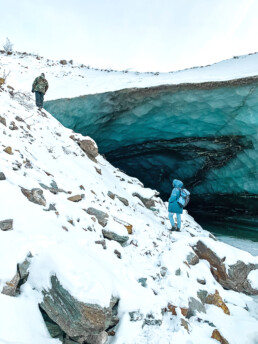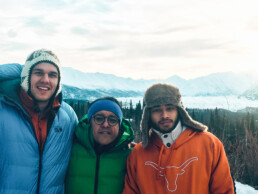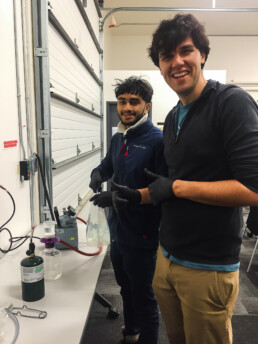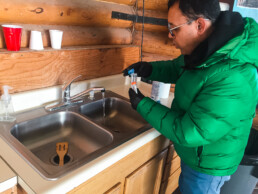Navid Saleh has dedicated years of his career to helping native populations across the U.S. manage and improve the quality of their water. It started in 2012 when he visited the Navajo Nation, and he later expanded this mission to help Texas border communities.
But along the way, he witnessed distrust. Groups long persecuted by government authorities were resistant to people coming in and telling them what to do with their own resources.
That’s why he is taking a different approach as he embarks on his latest project — to help Alaska natives manage their water resources. Saleh, an associate professor in the Department of Civil, Architectural and Environmental Engineering, is leading a multi-year effort, teaming up with colleagues from the University of Alaska Fairbanks, renowned ethnographers and the native communities themselves to create a playbook to project the future of their water resources and manage them.
Saleh hopes this collaborative, cross-disciplinary approach that combines data with local knowledge and includes community members on the research team will re-build trust.
“Working with these communities, being there, learning with them, is important to make this knowledge work. You can’t just go in there and tell them there is a problem with their water, that they have to fix it and expect them to listen.”
—Navid Saleh
Saleh’s research with native populations has mostly focused on Texas and the Southwest. But he became interested in the state nearly 4,000 miles away from UT Austin because of a unique combination of the strong native culture in Alaska and the impacts that climate change threatens to unleash on the state.
Saleh’s 2012 visit to the Navajo Nation as a faculty member at the University of South Carolina put him on the path of working with native communities. From the 1940s to the 1980s, the federal government mined millions of tons of uranium ore from the land of the Navajo Nation, a process that left the people with a toxic water supply and tons of waste. Today, many of those mines remain open and abandoned, and some members of the Navajo Nation still don’t have access to potable drinking water.
Saleh began working with a student, Lewis Stetson Rowles III, to remedy this. The two later came to UT and continued the work, redesigning Navajo pottery and infusing nanoparticles to make it a formidable water treatment and filtering device. They then taught members of the Navajo community to build the devices using resources they already have available.
The research team — Lewis Stetson Rowles III, Navid Saleh and Areeb Hossain — in Alaska. Rowles and Hossain are students of Saleh’s.
Building on this, Saleh turned his focus to the Texas-Mexico border, where he is working with colonias, rural communities near the border that lack access to high-quality water, sewage and housing, to develop ways to improve their water quality.
Arsenic, a highly toxic material that poses great public health threats, has consistently contaminated water in these colonias. As Saleh looked for other communities to work with, he eyed areas with similar arsenic issues. And reports of increasing levels of arsenic in Alaska’s water — combined with the water quality implications of climate change — was another factor that led him to focus on the only state in the U.S. that is larger than Texas.
Arsenic was a flash point for me,
Saleh said. It was eye-opening for me to see people in the Navajo Nation filling up tanks with tens of gallons of water at a time, with arsenic as high as any place in the world.
In addition to scientific study, the team will seek to learn more about the Alaskan communities’ historical management of their water supply. This part of the project involves extensive interviews with residents, photo and video elements and public forums to gather feedback and develop community-supported ideas for water management.
Combining historical and institutional knowledge with data has gained popularity in the scientific community. And while papers have been published about the convergence of science and native knowledge as it relates to fishing in Alaska, such a study about water management has never been done,
Saleh said.
The Alaska project just received a grant from the National Science Foundation’s (NSF) 10 Big Ideas program that drives the organization’s long-term research agenda. One of those big ideas is Navigating the New Arctic.
NSF aims to fund projects that will rectify a lack of tools to observe and analyze the region as it undergoes rapid change. Melting Arctic Sea ice and other trends will have dramatic impacts on climate and ecosystems across the globe, and there’s a lack of understanding of what these changes will mean for economy and security.
During the four-year project, the team will analyze four bodies of water in the state, including a lake impacted by melting permafrost, as well as glaciers and the rivers and lakes they feed into. They will analyze water quality indicators, such as dissolved organic carbon concentration and composition, metals and microbial ecology.
Examining the quality of water encased in melting permafrost and glaciers is an important part of the project. Sea-level rise has garnered plenty of attention, but information about climate change’s impact on water quality remains sparse,
Saleh said.
There is little information about the microbes that will be released in the Arctic in the decades to come,
Saleh said.
The COVID-19 pandemic has forced the team to reshuffle their plans to travel to Alaska to avoid putting native communities at risk. They will still be able collect samples from the glaciers and permafrost but will visit the state at a later date.
We don’t want to be seen as intruders, especially during the pandemic,
Saleh said.
The team will rely heavily on Knik Tribe member Theo Garcia, whose role has become even more important with the onset of the pandemic. He will now take the lead on outreach with the Native communities.
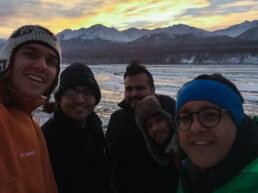
The researchers aim to create a set of tangible water management guidelines and actionable items tailored to each community’s water source. On a broader scale, the team hopes its work will increase knowledge about water quality issues in Alaska and help communities prepare for the impacts of climate change and evolving conditions in the Arctic.
Working with these communities, being there and learning with them is one of the best ways to make this knowledge work,
Saleh said. You have to learn the way they learn.
Saleh and Mary Jo Kirisits, associate professor in the Department of Civil, Architectural and Environmental Engineering make up the UT contingent. Working with them are assistant professor Srijan Aggarwal and professor Yuri Shur of University of Alaska Fairbanks’ College of Engineering and Mines, and Mikhail Kanevskiy, research assistant professor in the Water and Environmental Research Center. Other team members include Garcia; Laura Eichelberger, senior epidemiology and health research consultant with the National Tribal Water Center; and Henry Huntington, an Alaska-based researcher who studies Arctic policy, human-environment interactions and traditional knowledge in native communities.
Saleh and his team published a paper on water quality in Alaska earlier this year. Past experiences, and the federal push to develop a greater understanding of the Arctic, led him to pursue the more holistic approach. Saleh’s research focuses on three core tenets: engage with communities, evaluate their issues and then engineer solutions. And he believes you can’t have one without the others.
You can engineer any solution you want,
Saleh said. But, particularly in low-income and minority communities, if you don’t work with the communities, it is unlikely those technologies or solutions will be adopted.
